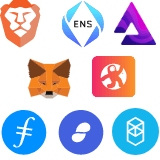The world's highest performance
blockchain mainnet
Providing customized blockchain solutions
that can be applied to all businesses
WEB 3.0
SigmaChain provides decentralized solutions based on blockchain,
which is a core technology of the Web 3.0 era.
WEB 1.0

Read Only
In 1991, British computer scientist Tim Berners-Lee unveiled the World Wide Web to the world, marking the beginning of the Web 1.0 era that spanned until 2004. Web 1.0 was characterized by static webpages that were limited to "Read" functionality and lacked interactivity beyond clicking. In essence, it was a service where the majority of users could only "Read" the limited content provided by a small number of users.
- Information Economy
- Search for webpage materials such as news, papers, etc.
- Structured Data
WEB 2.0

Read, Write
As we entered the 2000s, the web experienced rapid development with the proliferation of Internet services and the rise of various devices. Users who were once limited to simply "Reading" web content began to actively "Produce" and "Share" their own content, and actively "Participate" in the online ecosystem. Web 1.0, which was characterized by simple webpages with one-way communication, evolved into Web 2.0, a platform that enabled two-way communication.
With the advent of smartphones, accessing the Internet became easier for users, and through platforms provided by companies, they could freely share services among different devices and systems. As a result, platform operators such as Naver, Google, and Facebook, who provided various services for free with simple registration, naturally gained significant influence as the role of platforms grew. Users actively utilized these services to communicate with each other and generate data.
However, in Web 2.0, the connection between users was only possible through intermediaries in the form of platforms, which strengthened the power of the companies that owned these platforms. As a response to this, the concept of the "Decentralized Web" emerged. The most significant keyword of Web 3.0, "Decentralization", can be achieved through the blockchain system.
- Platform Economy
- Blogs, Twitter, Facebook, YouTube, etc.
- Structured + Unstructured Big Data
WEB 3.0

Read, Write, Own
Blockchain is a revolutionary data processing technology that distributes and stores data across multiple nodes using the Peer-to-Peer (P2P) method, without the need for a central server. With data managed by an unspecified number of nodes, there are no central authorities in control. This allows Web 3.0 to break free from centralized control, as data is encrypted and individuals can own it through an open and decentralized blockchain platform. Currently, we are witnessing the ongoing process of decentralization in various forms, such as Decentralized Applications (DApps), Decentralized Finance (DeFi), Decentralized Identifiers (DID), and more.
- Ownership Economy
- Blockchain, Semantic Web, AI(Artificial Intelligence), Metaverse, etc.
- Structured + Unstructured Big Data(including 3D Data)
- Internet Environment with Decentralization and Ownership
- Token Economy
Comparison of Web 3.0 Personal Data Ecosystem Model
For the Web 1.0 generation, individual companies have owned the personal data. Since the advent of the Web 2.0 generation in the 2000s, platform companies such as Google, Facebook, Alibaba, and Amazon owned personal data. Web 3.0 can be freed from central control by encrypting personal data and allowing individuals to own it through an open and decentralized blockchain platform.
-
WEB 1.0
API Ecosystem Model
Owned by Individual Companies
-
WEB 2.0
Platform Models
Owned by Platform Companies
-
WEB 3.0
MyData Models
Privately Owned


